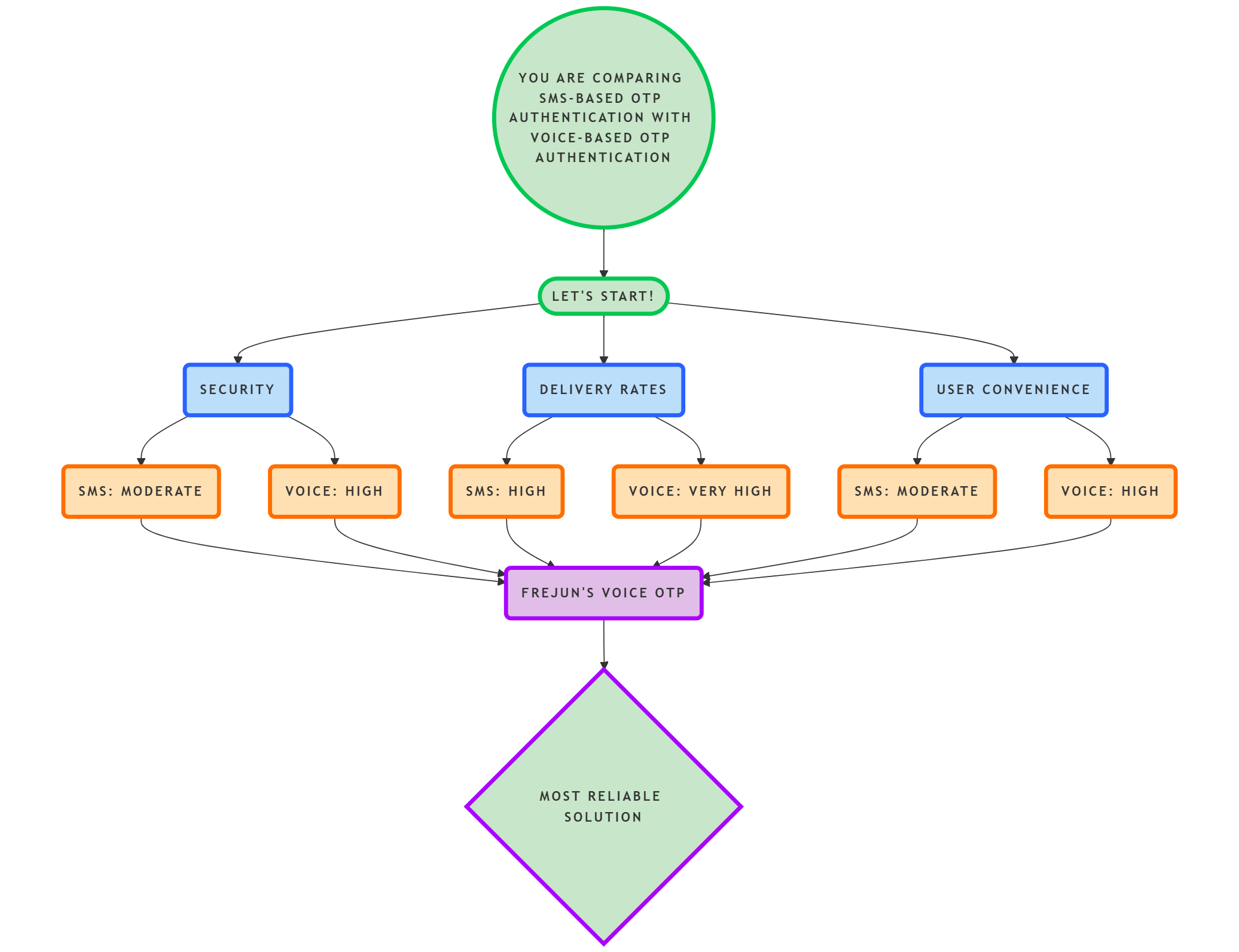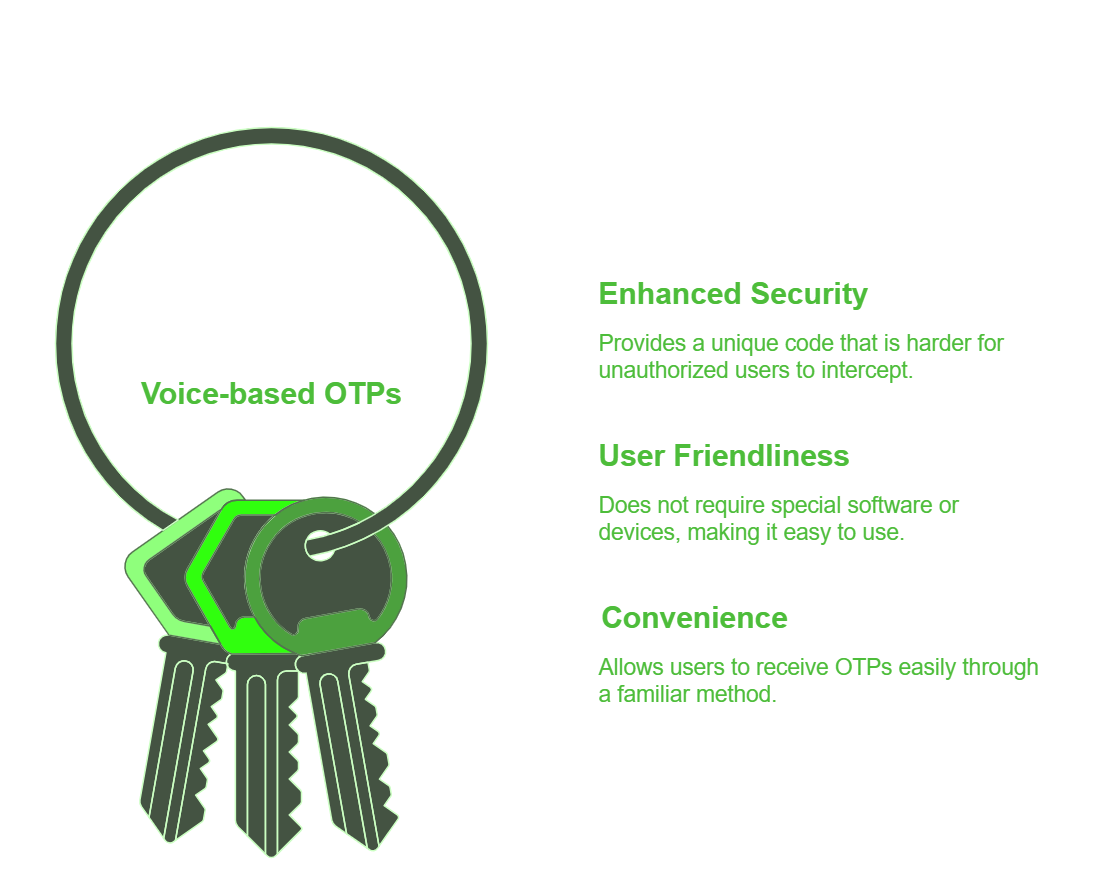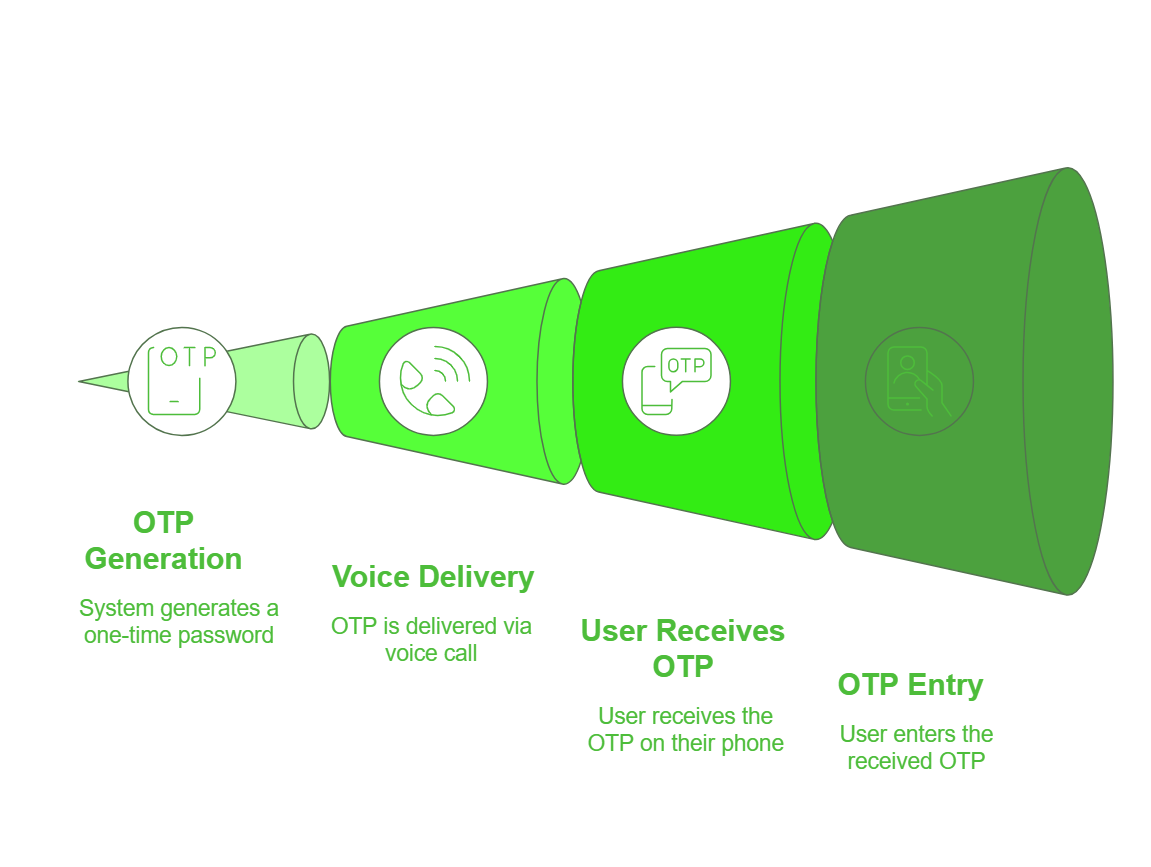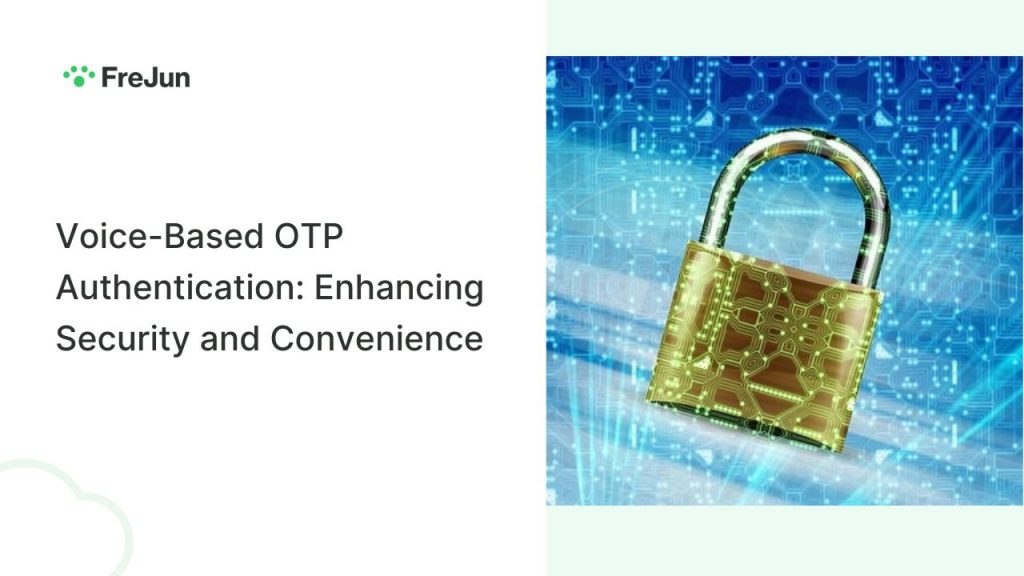Last updated on June 14th, 2025 at 01:55 pm
Data security is paramount, organizations are constantly seeking innovative ways to protect their customers’ sensitive information. One such solution that has gained popularity in recent years is Voice-Based OTP (One-Time Password) authentication. This cutting-edge technology not only enhances security but also offers unparalleled convenience for users. In this article, we will delve into the concept of Voice-Based OTP authentication, explore the technology behind it, discuss its benefits, and provide insights on implementing this solution in businesses. We will also address potential challenges and provide solutions for a smooth transition to Voice-Based OTP authentication.
Table of contents
- What is Voice-Based OTP Authentication?
- SMS OTP vs. Voice-Based OTP Authentication
- Secure Voice-Based OTP Authentication
- The Technology Behind Voice-Based OTP Authentication
- Key Features of Voice-Based OTP Authentication Across Industries
- How Does Voice Recognition Work?
- The Role of Artificial Intelligence in Voice Recognition
- The Benefits of Voice-Based OTP Authentication
- Implementing Voice-Based OTP Authentication in Business
- Potential Challenges and Solutions with Voice-Based OTP Authentication
- Frequently Asked Questions
What is Voice-Based OTP Authentication?
It is a method of verifying users’ identities by utilizing their unique vocal characteristics. Just like traditional OTPs, Voice-Based OTPs provide an additional layer of security during the authentication process. However, instead of receiving a code via SMS or email, users are prompted to speak a random passphrase. This is then analyzed using voice recognition technology. This ensures that only authorized individuals gain access to their accounts, making it significantly harder for hackers to impersonate them.
The Evolution of OTP Authentication Methods has come a long way, and Voice-Based OTP is the next step in this progression. Previous methods like SMS, email, or hardware tokens have their own limitations. SMS and email-based OTPs can be intercepted, while hardware tokens are inconvenient to carry around. Voice-Based OTP authentication overcomes these limitations by providing an additional layer of security while offering unmatched convenience to users.
SMS OTP vs. Voice-Based OTP Authentication

Advantages of Voice-Based OTP
One of the key advantages of Voice-Based OTP Authentication is its ability to leverage the unique characteristics of an individual’s voice. Each person has a distinct vocal pattern. This can be analyzed and compared to the stored voiceprints in the authentication system. This makes it extremely difficult for attackers to replicate or mimic someone else’s voice accurately.

Moreover, Voice-Based OTP Authentication is not only secure but also user-friendly. Users no longer need to remember complex codes or carry physical tokens with them. They can simply speak the passphrase, and the system will authenticate their identity in real-time. This simplifies the authentication process and reduces the chances of errors or forgotten passwords.
Another interesting aspect of Voice-Based OTP Authentication is its potential applications in various industries. For example, in the banking sector, voice authentication can be used to verify customers’ identities during phone banking transactions. This makes it more secure than traditional PIN-based systems. In healthcare, voice authentication can enhance patient privacy and ensure that only authorized personnel have access to sensitive medical records.
Furthermore, Voice-Based OTP Authentication can also be integrated with other biometric authentication methods, such as fingerprint or facial recognition. This multi-factor authentication approach adds an extra layer of security. It combines different unique identifiers to verify the user’s identity.
As with any authentication method, Voice-Based OTP Authentication does have its limitations. For instance, background noise or changes in a person’s voice due to illness or fatigue is a concern. This can potentially affect the accuracy of the authentication process. However, advancements in voice recognition technology continue to address these challenges, making Voice-Based OTP Authentication even more reliable.
Secure Voice-Based OTP Authentication

The Technology Behind Voice-Based OTP Authentication
So, how does Voice Recognition work? Voice recognition technology analyzes a user’s unique vocal characteristics, such as pitch, tone, cadence, and accent, to create a voiceprint. This voiceprint is then matched against a user’s previously stored voiceprint, which ensures accurate and secure authentication. Artificial Intelligence plays a crucial role in this process. It continuously fine-tunes the voice recognition algorithms and improves the system’s accuracy over time.
Voice recognition technology has come a long way since its inception. It is now capable of accurately identifying individuals based on their voice patterns, even in noisy environments. This is achieved through advanced noise cancellation techniques that filter out background noise and focus on the user’s voice, ensuring reliable authentication even in challenging conditions.
Key Features of Voice-Based OTP Authentication Across Industries
| Industry | Security Level | User Convenience | Fraud Prevention | Accessibility | Integration Ease |
| Banking & Finance | High | High | Prevents phishing & SIM swap fraud | Moderate | Easy |
| E-commerce | Moderate | High | Reduces fraudulent transactions | High | Easy |
| Healthcare | High | Moderate | Secures patient data | High | Moderate |
| Government | Very High | High | Ensures identity verification | Moderate | Moderate |
| Enterprises | High | Very High | Prevents unauthorized access | High | Easy |
| Telecom | High | Moderate | Secures customer authentication | High | Moderate |
How Does Voice Recognition Work?
When a user speaks the passphrase, their voice is captured and converted into a digital format. This digital audio is then processed using complex mathematical algorithms to extract unique voice patterns. These patterns are matched against the existing voiceprint stored in the system, and if the match is successful, the user is granted access.
One of the key challenges in voice recognition is dealing with variations in voice due to factors such as age, health conditions, and emotional state. To overcome this, voice recognition systems employ sophisticated machine learning algorithms that can adapt to these variations and still accurately authenticate the user. This adaptability ensures that the system remains effective even as users’ voices change over time.
The Role of Artificial Intelligence in Voice Recognition
Artificial Intelligence is what powers the continuous improvement of voice recognition systems. By analyzing vast amounts of voice data, AI algorithms can adapt and learn from patterns, making the authentication process more accurate and efficient over time. This allows the system to better identify individual voices while minimizing false positives or false negatives.
AI also plays a crucial role in enhancing the security of voice-based OTP authentication. It can detect and prevent voice spoofing attempts, where an attacker tries to mimic someone else’s voice to gain unauthorized access. Through continuous monitoring and analysis, AI algorithms can identify suspicious patterns and distinguish between genuine and fraudulent voice inputs, ensuring the integrity of the authentication process.
Furthermore, AI enables voice recognition systems to be context-aware. This means that the system can adapt its authentication criteria based on the specific context in which the user is requesting access. For example, if the user is in a noisy environment, the system may adjust its noise cancellation algorithms to better capture the user’s voice. This contextual awareness enhances the overall user experience and ensures reliable authentication in various real-world scenarios.
In conclusion, voice-based OTP authentication relies on advanced voice recognition technology and artificial intelligence to accurately and securely authenticate users. Through continuous improvement and adaptation, these systems provide a reliable and efficient means of authentication, ensuring the integrity of sensitive data and transactions.
The Benefits of Voice-Based OTP Authentication
Enhancing security is the primary objective of any authentication method, and Voice-Based OTP authentication achieves precisely that. By utilizing users’ unique vocal characteristics, it adds an additional layer of security that is incredibly difficult for hackers to bypass. Even if someone manages to obtain a user’s login credentials, Voice-Based OTP authentication acts as a reliable barrier against unauthorized access.
1. Enhancing Security with Voice-Based OTP
The human voice is an incredibly distinct and hard-to-replicate identifier. By leveraging voice recognition technology, Voice-Based OTP authentication verifies users’ identities with a high level of accuracy, making it significantly more secure than traditional methods. This enhances security for both individuals and organizations, protecting valuable data from unauthorized access.
2. The Convenience Factor: Why Voice-Based OTP Stands Out
In addition to improved security, Voice-Based OTP authentication offers unparalleled convenience for users. Unlike traditional OTP methods that require users to enter codes manually or carry around physical tokens, Voice-Based OTP eliminates these extra steps. Users can simply speak the passphrase, avoiding the hassle of typing long codes or carrying additional hardware. This seamless user experience sets Voice-Based OTP authentication apart from other methods.
Implementing Voice-Based OTP Authentication in Business
Now that we have explored the concept and benefits of Voice-Based OTP authentication, how can businesses integrate this solution into their systems? Let’s discuss the necessary steps and best practices for a successful implementation.
Steps to Integrate Voice-Based OTP in Your Business
Implementing Voice-Based OTP authentication requires careful planning to ensure security, user convenience, and seamless integration with existing systems. Here’s a step-by-step guide to help you through the process:
1: Identify a Suitable Voice OTP Provider
- Research and shortlist voice OTP service providers.
- Compare features like accuracy, scalability, security, and compatibility with your existing systems.
- Choose a provider that meets your business needs and budget.
2: Plan Integration with Your Authentication System
- Define where and how the Voice OTP will be used (e.g., login, payment verification, account recovery).
- Ensure your infrastructure supports the integration (API support, cloud compatibility, etc.).
- Determine if you need additional software or hardware upgrades.
3: Develop the Voice OTP System
- Work with the provider to integrate their API into your authentication workflow.
- Configure settings like OTP generation, expiration time, retry limits, and language preferences.
- Develop or modify the user interface to ensure a smooth experience.
4: Test for Functionality & Security
- Conduct internal testing to verify the OTP delivery speed, voice clarity, and accuracy.
- Test under different network conditions to ensure reliable performance.
- Perform security audits to detect vulnerabilities and prevent fraud attempts.
5: Launch & Monitor Performance
- Roll out the Voice OTP feature in a phased manner (pilot testing before full deployment).
- Provide users with guidelines and support for a smooth transition.
- Continuously monitor usage, feedback, and optimize performance based on real-world data.
6: Ensure Compliance & Regular Updates
- Stay compliant with data protection laws (GDPR, CCPA, etc.).
- Update the system regularly to improve security and user experience.
- Monitor emerging trends in voice authentication and upgrade when necessary.
Potential Challenges and Solutions with Voice-Based OTP Authentication
Although Voice-Based OTP authentication offers numerous advantages, it is essential to consider potential challenges and adopt appropriate solutions to ensure a smooth transition.
1. Addressing Common Concerns with Voice-Based OTP
One common concern is the fear of false positives or negatives during the authentication process. However, advancements in AI algorithms and continuous learning models significantly reduce these occurrences. Additionally, implementing fallback authentication methods, such as password-based authentication, can provide an extra layer of security and peace of mind for users.
2. Overcoming Hurdles: Tips for a Smooth Transition to Voice-Based OTP
Ensuring a smooth transition to Voice-Based OTP authentication requires proper planning and communication with users. Educating users about the benefits and security enhancements offered by Voice-Based OTP can help alleviate any concerns they might have. It is also crucial to provide clear instructions and resources to ensure a seamless user experience during the authentication process.
As technology continues to evolve, Voice-Based OTP authentication proves to be an innovative and reliable solution for enhancing security and convenience. By leveraging voice recognition technology and artificial intelligence, organizations can provide their users with a secure and effortless authentication experience. With proper implementation and consideration of potential challenges, Voice-Based OTP authentication has the potential to revolutionize the way we protect our digital identities.
Conclusion
As cybersecurity threats continue to evolve, businesses must adopt advanced authentication solutions. Voice-based OTP authentication offers an ideal balance of security, convenience, and accessibility, making it a must-have for businesses in 2025.
For enterprises looking for a fast, secure, and AI-powered authentication system, FreJun’s cloud telephony solutions provide seamless voice-based OTP delivery with high reliability and fraud protection. Stay ahead in security innovation with FreJun! 🚀
Further Reading: Top 10 Voice OTP Providers
Frequently Asked Questions
The system calls the user and reads out a unique OTP; FreJun automates this for quick delivery.
Yes, it’s less prone to SIM-swapping or SMS interception, especially when powered by tools like FreJun.
Absolutely — with platforms like FreJun, you can send voice OTPs across countries seamlessly.
Finance, healthcare, and e-commerce widely use it, and FreJun supports integration across these sectors.
Yes, it aids users with limited literacy or visual challenges — FreJun ensures clear voice delivery.
Typically within seconds; FreJun optimizes call speed and minimizes delays.
Yes, systems like FreJun fully automate the generation, calling, and reporting process.
Subhash is the Founder of FreJun, the global call automation platform. With 8+ years of entrepreneurial experience, FreJun was established to help customers with their voice communication needs. The goal of FreJun is to develop cutting edge technology and solutions to help customers.
